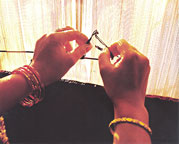With each row the weft was laid, the shed changed, the
loops slit, and the pile clipped; the weaving cycle would begin again
with the hitching. The process was a three-dimensional tensioning, dependent
on the spacing of the warp, the thickness of weft, and the tightness
of knot. This was peculiar to each weaver, and perhaps each loom. Together
they would yield a certain ratio. Some knots were square and others
rectangular. This determined how many knots would fill a space or produce
a curve. Somewhere within each weaver this ratio was known, as a tactile
sensation of a mathematical certainty.
Carpet weaving was the original folk art of Tibet. Compendiums
of design and stylistic formulae were never compiled; most weavers were
illiterate. It encompassed generations of extended families, and an
oral tradition. It was truly a folk art, for it was totally anonymous.
There were no great schools, and no great artists. Carpets were woven
in such distant places as Nylam, on the Nepalese border, and Kum Bum,
in Amdo; yet no attempt was made to define the weaving styles geographically.
Old carpets were copied in new colors and arrangements. They were woven
for sale, or as offerings.
A woman, looking after her cousin's small child, tied knots in her free
time. Young couples wove, while their parents spun and skeined. The
weavers were men and women of every manner and bearing. They were occasionally
combed and oiled; but generally they wove through the bazaars with their
long hair dishevelled, a timeless hunch and a preoccupied look. Weavers
were a low rung on the feudal ladder, yet carpets were used by all segments
of society. For king or nomad, the carpet was an essential element of
every occasion, from picnic to wedding party. Their craft was a dimmer
light in the spectrum of graphic arts. They were inevitably associated
with alcohol, snuff, fleas, gossip, and many a colorful story.
Individualistic to the extreme, they could not weave
a pattern straight without some alteration. They were reluctant to weave
on another's warp, yet it was rarely a solitary art. They wove on separate
steel bars in teams, and slashed and hammered through the weaving cycle
in unison. When they chanted, they chanted together. Some were weavers
of such excellence that they could weave from a template, a memory,
or even spontaneously. Whatever the design, it was only completed in
wool. Even while weaving in a patron's house, it was ultimately the
weaver who tied the knots that shaped the rug's destiny.
They may have been prideful and partisan, but their craft followed an
old, well-worn path. And they followed it religiously. Their motives
were not artistic. They did not hope to develop their craft. The purpose
of weaving was to weave, year in, year out, before the looms. They would
weave and weave, and with each hitch tied, another would loosen inside
them.
Actually, there was nothing to it. This, sooner or later,
was the realization of every weaver. No matter how intricate the design,
there was nothing outside the weaving cycle. From the knots to the stringing
of the looms, right down to the very fibers groomed, spun and dyed,
there was not one thing that could be seen as an independent entity.
Behind the weaving cycle there was nothing but a web of tensions, and
beyond that there was nothing at all.
There were no binding rules to follow, no yardsticks
of excellence to apply. Carpet weaving was not a decorative art meant
to flatter, nor was it a commercial art, for it wasn't competitive.
It had a purity that was not merely child-like. Traditional weaves had
a raw, unprofessional quality that transcended understatement. In the
end, the weavers did not respond to popular trends and stylistic formulae.
They did not look to the objects themselves and weave what seen, or
what they wished them to be. Each knot was a response to the weaver's
own weave and her own fertile imagination. She added nothing. This was
only tradition.
While the yarn, staked to the warp face, spread like
guy wires from their hands, they drank tea and told their dreams. Deep
into the tangle, they would nap, head on hands, fingers embedded in
the warp. The weaving state lies somewhere between the dream and the
waking. Weaving means continuum. It means to know the world, and to
complete it. Weaving connects all processes and peoples in one fabric,
with one act.
The finished rug wasn't the end. Once it was trimmed,
sheared and cut from the loom, they strung up again. Weaving was well-practiced;
the rug, well-used. Carpets wore from the center out, and were replaced
like their very clothing, by putting another over or under the worn
piece, depending on occasion. Their rugs wore down to a pileless sheen.
The final tribute to their craft was that almost nothing survived.
What survived was the practice of hitching, tying off,
and cutting through. In it they grounded their vision, and perfected
their view. In the space of one knot swooping down over the bar, they
listened to wisdom's descent. It rolled off their looms, spilled out
the doorways and onto the streets to mix with life's great tangle.

